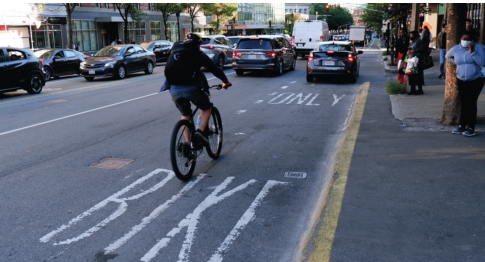
A bike lane on Mass AveBerkeley Street is the latest candidate in Mayor Michelle Wu’s push for bike accessibility, but drivers are starting to feel the squeeze as the Back Bay’s potential lane losses mount.
The project was first made public on January 23 when the city published a webpage outlining in loose terms their intention to connect Tremont and Newbury Streets with a separated bike lane.
The transportation department confirmed it’s spent the past few months measuring existing conditions along the route such as traffic volume. Planners are now collecting public input to refine into a concrete blueprint.
Their main point of contact is the department’s public office hours, held every other Wednesday. Interested residents can schedule an appointment through the city’s online events calendar.
“Today,
people who want to bike from the South End to the Back Bay don’t have
great options. We aim to complete a missing link in our bike network
between Tremont Street and Beacon Street,” reads the connection’s
announcement page.
“Commuters
will be able to reach job centers in the Back Bay and beyond, and
everyone will be able to safely bike between two vibrant shopping,
dining and entertainment districts.”
The
Boston Cyclists Union was supportive of the proposal. The Union
frequently pushes for protected bike lanes, and one of the only specific
elements the city is currently advertising about the bike lanes is that
they will be “separate.”
“More
bike infrastructure is good bike infrastructure. Mayor Wu has said
creating safe alternative transit infrastructure is a priority, and
there’s a lot of pedestrian traffic already in those areas. As more bike
infrastructure is installed it will be even easier for people to get
there,” said Grey Black, the Union’s director of organizing.
The
Neighborhood Association of the Back Bay (NABB) was less enthusiastic.
NABB President Elliot Laffer said they were open to transportation
improvements but skeptical that Berkeley Street could take much more
pressure.
That doubt
is exacerbated by the city’s flirtation with making Dartmouth Street
pedestrian only in front of the Boston Public Library, a proposal whose
traffic impact mitigation relies on diverting cars to Berkeley.
“We
don’t know a lot about the plans yet, but any time you do something
with Berkeley Street it raises concerns because it’s already so
congested,” said Laffer. “We already have great concerns about closing
Dartmouth Street. If Berkeley loses a lane where do they go?”
NABB is holding off taking an official position until an actual blueprint is proposed.
“You
can’t just say ‘well we want to get bikes from one area to another and
Berkeley seems like an obvious place to put them.’ There aren’t that
many streets coming through the Back Bay. You need a comprehensive
thought instead of individual plans that aren’t connecting in a way we
can see,” said Laffer.
For proponents like the Union, public safety takes priority over traffic concerns.
“Not
creating physical space on the road doesn’t mean people won’t still use
the road,’ said Black. “I’ve got places I need to go and people I need
to see, and I’m going to use roads whether the infrastructure is there
or not. Creating dedicated space for bikes makes sure it’s safe when I
do.”